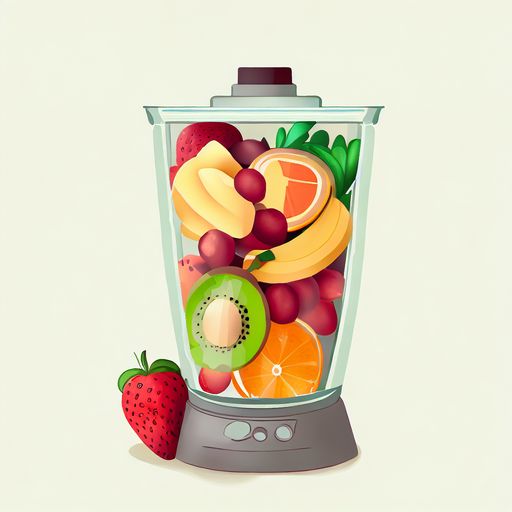Can You Put Whole Fruit In A Blender?
Blending whole fruits into delicious smoothies is a great way to get more fruits into your diet. The convenience of throwing ingredients into a blender makes it easy to whip up a nutritious beverage in minutes. But can you put whole, uncut fruit into a blender?
Blending Whole Fruits: The Benefits
Blending whole fruit, skin and all, provides maximum nutrition and fiber. The skin contains valuable phytonutrients, antioxidants, and fiber that are lost when the skin is removed. Leaving the skin on apples, pears, kiwis, and other fruits boosts the nutritional value of the smoothie.
Whole fruits also add natural thickness to smoothies, creating a richer, sweeter taste and texture. Pre-cut fruits tend to release more liquid during blending, creating a thinner, watery blend.
Blending whole fruits saves prep time. No need to core, peel, pit, or slice fruits before adding them to the blender. Just rinse the fruit and drop it in. This makes smoothies the perfect fast breakfast or snack on busy mornings.
Which Fruits Can Be Blended Whole?

Many fruits can be blended whole without any prep or slicing. Fruits with edible skins and soft seeds are the best candidates for blending whole. Good examples include:
- Bananas – Blend whole with peel for added fiber.
- Berries – Raspberries, blackberries, blueberries and strawberries can be blended whole and unwashed even.
- Kiwis – Blend whole after washing the thin fuzzy peel.
- Avocados – Blend the flesh whole, without the pit.
- Mangoes – Dice mango flesh into chunks and discard pit before blending.
- Melons – Blend whole chunks of watermelon, honeydew, cantaloupe with rinds and seeds.
- Figs – Drop in whole after washing.
- Grapes – Leave whole or cut in half if large.
- Currants – Blend whole bunches.
- Cranberries – Wash before adding whole to the blender.
- Cherries – Use whole pitted cherries or remove pits from fresh cherries.
Blending these fruits whole maximizes nutrients, fiber, and smoothie volume. The seeds, peels, and skins all provide additional health benefits.
Can You Blend Fruits With Pits and Seeds?
Many whole fruits contain pits and seeds that are safe to blend. Seeds add fiber, healthy fats, and nutrients to smoothies. Examples of blends safe to use whole include:
- Kiwis – Tiny edible seeds blend smoothly into the mix.
- Raspberries – The small seeds are easily incorporated.
- Blackberries – The tiny seeds won’t damage blenders.
- Cranberries – Blend with the edible seeds whole.
- Cherries – Use pre-pitted or be sure to pit before blending.
- Grapes – Small edible seeds blend well.
- Currants – Blend into smoothies seeds and all.
- Figs – Tiny seeds can be blended in.
Seeds from fruits like apples and pears should be avoided as they contain traces of cyanide. Be sure to core and deseed them first. Citrus fruits like oranges, lemons, and limes can be blended peeled with membranes removed to avoid bitter seeds.
Fruits to Prep Before Blending
Some fruits must be prepped before blending to avoid damaging blenders from large pits and seeds. Follow these tips when using these fruits:
- Avocados – Remove pit and scoop out flesh in chunks to blend.
- Mangoes – Peel, pit, and slice mangoes before blending.
- Nectarines – Cut in chunks and remove pits first.
- Peaches – Remove pits before blending. Ripe peaches can blend with skin left on.
- Plums – Slice and remove pits from plums before blending.
- Cherries – Use pre-pitted or be sure to pit fresh cherries.
- Olives – Remove pits from olives before adding to smoothies.
- Coconuts – Remove coconut meat from shell before blending.
- Pineapples – Peel, core, and cube flesh before blending.
Proper prep removes potentially damaging pits while retaining maximum fiber and nutrients from the fruit flesh and skin.
Can You Blend Fruit Skins and Peels?

For fruits with edible peels, blend skins and all for added nutrition. Softer fruit skins contain valuable antioxidants, enzymes, fiber, vitamins, and minerals.
Good fruits for blending peeled include:
- Apples – Blend with peel, but remove core first.
- Pears – Remove core then blend with peel.
- Kiwis – Blend fuzzy peel and all.
- Peaches – Blend peeled or with skin intact if ripe.
- Plums – Blend peeled after pitting.
- Bananas – The peel adds fiber, blend whole.
Citrus peels from oranges, lemons, limes, and grapefruits are too bitter and tough to blend whole. Peel citrus fruits before blending.
Can You Damage a Blender Blending Whole Fruit?
Modern blenders are designed to pulverize whole fruits into smooth liquids. But fruits with large pits and extremely hard seeds can potentially damage blades if blended whole.
To avoid damage:
- Remove all pits and stones from fruits like plums, peaches, mangoes, nectarines, dates, and olives before blending.
- Cut larger fruits like pineapples into smaller pieces to blend more smoothly.
- Avoid apple cores and citrus seeds which can scrape and chip blender blades.
As long as hard pits are removed and larger fruits pre-cut, whole fruits can be blended safely. High power blenders like Vitamix are ideal for blending whole fruits. Always read blender manuals for any size and prep guidelines.
Do You Lose Fiber Blending Whole Fruits?
Blending whole fruits retains the maximum amount of fiber, particularly from nutrient-rich peels. While extreme juicing and high-speed blending can break down some insoluble fiber, whole fruit blending preserves soluble fiber.
Soluble fiber is beneficial for:
- Improving cholesterol levels
- Regulating blood sugar
- Aiding digestion
- Reducing disease risk
So blending whole fruits with skins and peels provides all the benefits of fruit fiber in a convenient smoothie form.
Enjoy Nutritious, Whole Fruit Smoothies
Blending whole fruits makes for fast, nutritious smoothies packed with fiber, vitamins, and antioxidants. While certain fruits with pits and large seeds must be prepped first, many whole fruits can be tossed right into the blender.
Always read blender instructions for recommended fruit sizes to avoid potential damage to the blades. And be sure to remove all potentially toxic seeds and bitter components like citrus peels.
With the proper precautions, you can blend whole, unpeeled fruits for maximize nutrition. The next time a smoothie craving strikes, grab whole fruits from the fridge or fruit bowl and blend up a nourishing drink in minutes. Enjoy!
Let us know in the comments if you have any favorite whole fruits to blend or tips for getting the most nutrients from your smoothies.
